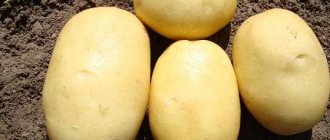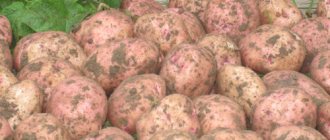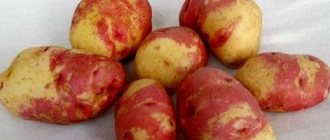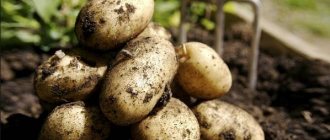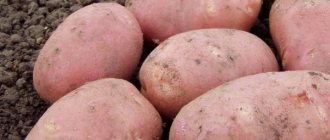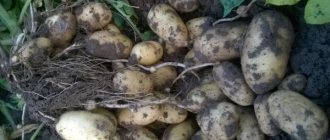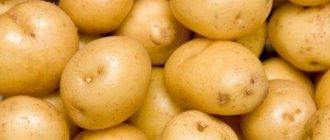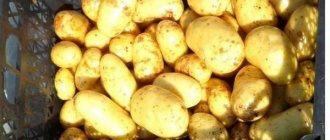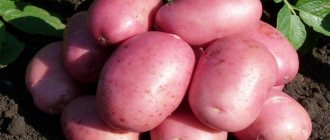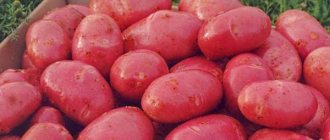Description of the potato variety Gulliver
Specialists from several organizations participated in the development of the Gulliver potato: “Radogoshch”, “Korenevo”, “Ural Potato”. An application for registration was submitted in 2015, after which the variety passed successful tests, and in 2021 it was included in the register of breeding achievements. The crop is approved for cultivation in the middle zone and Black Earth regions.
Main characteristics of Gulliver potatoes:
- early ripening (6070 days);
- table (mass fraction of starch 14-15.5%);
- tall (70-80 cm);
- plant of intermediate type.
Gulliver potato bushes are semi-erect, moderately spreading, with large green leaves of an intermediate type. The corollas are small, light lilac in color. The tubers are elongated oval in shape, the eyes are small. The surface is smooth, light beige. The pulp is creamy, moderately boiled, and has a good taste. A characteristic feature is the large size (5-8 cm in length) and weight of potatoes (100-140 g). That is why the variety was named Gulliver.
Important! The commercial yield of Gulliver potatoes ranges from 84% to 98%. This is a fairly high indicator, allowing the crop to be grown both for personal consumption and for sale.
Gulliver potato tubers are large and pleasant to look at
Growing and care
The Gulliver variety loves loose, light soils. Loams, transitional lands, and sandstones are suitable for cultivation. The maximum productivity was observed on chernozem. When the soil pH is acidic, ash, dolomite, and lime are added. The acidity reduction procedure is carried out no more than once every 4 years.
When seedlings emerge, they will need a fair amount of moisture. Water for the first time when the stems are 10-12 cm long. Moisture is needed during the growing season and flowering. When budding is complete, the potatoes are no longer watered. Moisture norm per 1 m2:
- 20-30 l after germination;
- 25-35 l during the growing season;
- 35-50 l at the active flowering stage.
The surface of the plot is treated with hoes, hoes, flat cutters (in vegetable gardens), and in the field conditions a cultivator is used. Loosening will provide sufficient aeration. Frequency: 1 time every 2 weeks, as well as after precipitation.
During the growing season, fertilizing is carried out 3 times according to plan: during planting, during the mass growing phase, during flowering (when tubers are formed). Potatoes need organic matter, phosphorus-potassium and nitrogen compounds.
Characteristics of the Gulliver potato variety
Gulliver potatoes are not resistant to night frosts, so they should only be planted in warm soil. However, the plants tolerate drought well - they need additional watering during the hot season. Keeping quality is 94-95%. Potatoes are not prone to cracking, so the tubers can be transported over long distances. Scope of application – universal: for frying, boiling, baking. It is acceptable to use in salads, okroshka, and for making stews.
Productivity
Gulliver potatoes are early varieties - they ripen in 2-2.5 months from the emergence of shoots. From 5 to 11 tubers are formed on each bush. The yield is:
- 0.7-1.4 kg from 1 bush;
- 1.6-2.8 kg per 1 m2;
- 160-280 kg per 1 hundred square meters.
The maximum yield was 371 kg per hundred square meters. To achieve similar indicators, Gulliver potatoes are recommended to be planted in fertile and light soil (loam or sandy loam). Also, summer residents and farmers are advised to follow the basic rules of agricultural technology:
- germinate tubers before planting;
- water during the dry season;
- hill up 2-3 times per season;
- prepare the soil before planting;
- also fertilize 2-3 times;
- loosen and weed as needed.
Advantages and disadvantages
Gulliver potatoes produce very large root crops that are distinguished by their attractive presentation and good taste. Summer residents value it for other advantages - for example, drought resistance and high productivity.
From one bush you get 5-10 large tubers
pros
- excellent taste;
- large tubers;
- good harvest;
- drought resistance;
- high keeping quality;
- transportability;
- immunity to certain diseases;
- undemanding to care.
Minuses
- not resistant to late blight on tubers;
- may suffer from return frosts;
- not approved for cultivation in all regions.
Diseases and pests
Diseases and pests of potatoes Gulliver
The good immune system of the Gulliver potato variety allows gardeners to encounter diseases and pests only in rare cases. This greatly simplifies the care of the crop. The Gulliver variety is not affected by potato canker, Alternaria blight, late blight, and potato nematode. But with improper care, some fungal diseases can occur.
Important!
Experts recommend treating young bushes to prevent rhizoctonia and scab. The variety has only average resistance to these diseases.
If serious problems arise, you must immediately treat the bushes with fungicides or insecticides and, if necessary, repeat the procedure after a while. As for the Colorado potato beetle, they fight it with manual assembly, traps, and bait.
Landing rules
Illuminated, level and dry areas are suitable for planting Gulliver potatoes (not in lowlands, without close-lying groundwater). The soil is moderately fertile, light, with a neutral or slightly acidic reaction. Soil preparation begins in September or April:
- They dig with a shovel on a bayonet.
- Add humus or compost up to 5-7 kg per 1 m2.
- If the soil is heavy, add sand or sawdust 500-800 g per 1 m2.
Gulliver potato tubers begin to be prepared a month before planting. They are laid out in a cool (14-15 degrees) room, in 2-3 layers on the floor or in boxes (exposed to light). They are periodically sprayed with water, and 2-3 hours before planting they are treated with fungicides (copper sulfate, Fitosporin, Khom) and growth stimulants (Kornevin, Zircon). All weak, damaged and dried tubers are discarded. The rest should have seedlings 1.5-2 cm long - this is a signal to start planting.
Since Gulliver potatoes are heat-loving crops, they can be planted no earlier than the first ten days of May, when the soil warms up to 10-12 degrees and the risk of return frosts will practically disappear. Check this with an outdoor thermometer by burying it in the hole for 10-15 minutes.
The landing algorithm is standard:
- Mark furrows at intervals of 60-70 cm in a north-south direction.
- Plant the tubers to a depth of 10-15 cm (the lighter the soil in structure, the more you can deepen).
- Leave a distance between adjacent holes of 30-35 cm.
- Dust with wood ash.
- Cover with soil.
The minimum planting depth of Gulliver potatoes is 10 cm permissible on light sandy loam soils
Care and harvesting
We recommend reading our other articles
- The best early grape varieties
- Pickled Green Tomato Recipes
- The best dairy cow breeds
- Gladiolus flower
Gulliver potato harvest
It is necessary to begin caring for potato beds no earlier than the first shoots appear. Before this, the plantings are not touched so as not to damage the sprouts hiding underground.
- Watering begins 1.5-2 weeks after planting. Average water consumption is 15-20 l/m. sq. However, this indicator may vary depending on climate and soil type. Potatoes of this variety especially need a lot of moisture during the period of tuber formation.
- The earth is loosened regularly. You should not forget about this rule. It is necessary to constantly maintain the row spacing in a well-groomed condition, remove weeds, weed the area between the bushes so that the potatoes have enough oxygen.
- Fertilizers guarantee rapid growth and excellent taste of the crop. Most of the nutrients are added when digging the site for the winter or during planting. And during the growing season, it is recommended to feed the crop only in certain cases, for example, if the plant grows slowly or the weather deteriorates. Thanks to the introduction of nutrients, the plant's resistance increases and it begins to develop normally again. Wood ash or minerals (phosphorus, potassium, nitrogen) can be recommended as a top dressing.
- Hilling is carried out 2 times per season. The first time – when the sprouts become 20 cm long on average, and the second – 2-3 weeks after the first procedure.
Features of cultivation
The agricultural technology of Gulliver potatoes is simple. Summer residents just need to follow the basic rules:
- In hot weather, water 3-4 bushes in a bucket (at least once a week). You can pour it under the root or between the rows, but then the volume of water increases slightly.
- Fertilizing with complex mineral fertilizer or organic matter (dung, mullein) after the tops reach 15-20 cm and after flowering.
- Hilling up - simultaneously with fertilizing. Work is carried out manually or mechanized.
- Loosening - after rains and watering.
- Weeding - regularly.
- Mulching the plantings with straw or sawdust – if possible.
Landing Features
Gulliver is most often grown by direct planting of tubers in the ground. Since the variety is new, when purchasing planting material you need to carefully inspect it: you may run into a fake or low-quality product. It is better to order and purchase potatoes from reliable suppliers and distributors. A summer cottage without shaded areas is suitable for cultivation; in a sunny place, the plants will germinate quickly, and the fruits will reach maturity earlier. Before planting, the following preparatory procedures are carried out:
- The tubers are germinated in advance. To do this, at the end of April (after the 20th), they take out selected planting material, select only healthy vegetables without signs of damage and leave them in a warm sunny place to grow shoots;
- the ground is plowed, organic fertilizers are added: mullein, chicken grass, ash, eggshells.
Attention!
For planting, you need to take medium-sized fruits. If the potato is too large, weighing 100 g or more, it is cut, but so that at least 2-3 shoots remain on each half.
Gulliver's planting begins no earlier than the beginning of May. Exceptions are the southern regions, where spring comes much earlier. The optimal time for planting work is chosen when the ground warms up to a depth of 20 cm to +10 degrees. If you plant tubers early, they may freeze, which will delay ripening and reduce shelf life.
When planting Gulliver, several simple requirements are observed:
- fruits are planted to a depth of no more than 20 cm;
- if there are slopes on the site, then the rows are placed across the slope;
- between adjacent bushes it is necessary to leave a distance of at least 30 cm, and between rows - at least 50 cm;
- For additional nutrition, you can add ash and rotted manure to the planting holes.
Potatoes sprout quickly in the second week after planting. Sometimes plants appear a little later, this may be due to the unfavorable climate of the region.
Pests and diseases
Potato Gulliver has good immunity to cancer and golden nematode. Resistance to other diseases is average:
- wrinkled mosaic;
- striped mosaic;
- late blight on tops.
However, there is no immunity to late blight in tubers. In addition, Gulliver potatoes can suffer from various pests - aphids, Colorado potato beetles, mole crickets, thrips and other insects.
Since it is very difficult to treat affected plants (if they are infected with fungal infections, it is better to immediately plant them and destroy them), gardeners recommend following basic preventive measures:
- Do not plant tubers in a field where potatoes, tomatoes, eggplants, sunflowers and other representatives of Solanaceae previously grew.
- Change the area every 3 years.
- If possible, plant potatoes in a field where legumes, root crops, winter crops or cucumbers previously grew.
- Be sure to treat the tubers before planting in a weak solution of potassium permanganate or fungicides.
- Treat grown tops with fungicides and insecticides.
To prevent fungal diseases, the following drugs are used:
- "Home";
- "Quadris";
- "Fitosporin";
- "Maksim";
- "Prestige";
- Bordeaux mixture.
In summer, the grown tops are dusted with wood ash (in the absence of wind and rain), and sawdust is poured between the rows. The plantings themselves can be mulched with straw. If there are too many insects, insecticides must be used:
- "Decis";
- "Karate";
- "Colorado";
- "Spark";
- "Agravertine";
- "Biotlin."
Advice! If possible, next to the Gulliver potatoes it is worth planting fragrant tobacco, calendula, marigolds, coriander and other plants that repel insects.
Before planting, Gulliver potato tubers must be pickled
Features of care
Taking care of growing crops is:
- in hilling;
- weeding and weed removal;
- loosening the soil;
- watering;
- fertilizer;
- preventive treatment of the future harvest from possible pests.
After planting the seed, no garden maintenance is required. However, after a 2-3 week period, the sprouts begin to germinate, and when their age reaches 7 days and they grow to 10–15 cm, they need to be earthed up. It is also necessary to remove weeds that may appear in the garden bed and interfere with the further growth of the potatoes.
The sprouts are hilled up in such a way that the mound of soil hides the entire stem, and only the leaves are visible above the soil surface.
After some time, this procedure is repeated, since the regularity of this procedure is the key to the successful formation of tubers.
Important! Hilling up Gulliver potatoes promotes the formation of large tubers and high yields.
Watering
A sufficient amount of moisture during flowering promotes the formation of potato tubers. During this period, the volume of water for irrigating a plot of 10 acres should be 20–30 m². The first watering is carried out 10–14 days after planting, and subsequently as the top layer of soil dries.
Taking into account weather conditions, at high temperatures and prolonged drought, watering the beds can be done by drip, controlling its volume.
Fertilizer application
During the entire growing season of potatoes, it is necessary to carry out 3 planned fertilizing applications:
- At the moment of landing.
- During the period of tops growth and flower formation.
- During the formation of potato tubers.
To fertilize the soil use:
- potash;
- nitrogen;
- phosphorus fertilizers.
Potatoes grow and develop well in soil saturated with minerals and nutrients, and the more of them there are in the soil, the larger the future harvest and taste characteristics will be.
Video: Feeding potatoes
Protection from diseases and pests
The variety has become resistant to many diseases and pests that can threaten the vital activity and yield of potatoes; in particular, Gulliver has good immunity:
- to cancer;
- fungal viral infections;
- mosaic;
- late blight.
Slightly susceptible to:
- Alternaria;
- nematode.
This variety may be susceptible to:
- scab;
- rhizoctonia.
For control, preventive treatment of bushes with copper preparations is used.
Among the pests that pose a danger to potatoes are:
- wireworms;
- Colorado beetle.
To combat them, you can use various special preparations, which are widely available in gardening stores.
Did you know? In the tropics you can find a potato tree, the height of which can reach 15 m. Its tubers have degenerated into roots, the flowering is 10 times larger than usual, and the berries are very similar to tomatoes, but they have a high content of toxins and are therefore poisonous to humans.
Harvesting and storage
Thanks to the short ripening period, Gulliver potatoes can be harvested as early as mid-July. Summer residents carry out 1 or 2 harvests:
- The first digging is 45 days after germination: the yield is 110-220 kg per 1 sq.m.
- The second digging - 55 days after germination: yield 155-278 kg per 1 sq.m.
The harvest is harvested on a warm and dry day, the root crops are slightly dried in the sun (do not cover with tops), sorted and put into bags. Too small and very large root vegetables are used first, and the rest are stored in a dark, cool room at a temperature of 12-15 degrees (the first half month), then 2-4 degrees and a relative humidity of 70-80%.
Advantages and disadvantages
Pros:
- large-scale productivity (600-700 centners per 1 ha);
- highly marketable and high-quality crops;
- friendly maturation;
- tolerance to drought and heat;
- excellent taste;
- unpretentiousness in cultivation;
- transportability without mechanical damage;
- convenience for mechanized maintenance (hilling up, loosening, cleaning);
- complex resistance to common nightshade infections.
Minuses:
- not suitable for northern regions (needs warm conditions).
Features of agricultural technology of the variety
The first step in the growing process is preparing the soil. Fertilize it with fertilizer enriched with minerals and nutrients. It is better to do this in the fall before the onset of frost by adding lime to the soil. 20-30 days before going deep into the ground, shake off the soil from the planting material and transfer it to a well-ventilated place. Treat each tuber with a weak solution of potassium permanganate.
Landing
Choose the most suitable place on the site for growing tubers; it should be well lit. Wait until the soil temperature warms up to 10-12 degrees and the night frosts disappear. Proceed with planting Gulliver potatoes as follows:
- Build a ridge up to 15 to 20 cm high if the groundwater in the area is located near the surface of the earth. This will save the root system from rotting.
- Dig holes or furrows so that the distance between them is at least 35-40 cm.
- Deepen the sprouted tuber into each hole so that it is located no lower than 8 cm from the soil level.
- Fill the hole or furrow with soil. Level the top surface of the ridge.
You can first cut the root vegetables into several parts, but each of them must have a vegetative shoot, which is responsible for the process of germination and reproduction.
On a note! Do not plant potatoes in a bed after growing crops belonging to the nightshade or sunflower family. Such a mistake during planting will lead to the development of a fungal disease. The best predecessors for this variety are cucumbers, beets, herbs or peppers.
Care
The good yield of the Gulliver variety depends not only on proper planting, but also on the competent care that this varietal crop requires. If the summer is dry, then water the plant 3-4 times per season - before the appearance and during the ripening of buds, before and after flowering. Periodically loosen the soil after planting the seed, this is necessary to improve oxygen saturation in it.
The Gulliver variety is distinguished by tall bushes, so carry out the hilling procedure 2-3 times a season, this is necessary to support and ensure good fixation of the plant crop. Throw soil onto the bush for the first time after it sprouts, then when it reaches a height of 15-20 cm, the last time after flowering.
Collection and storage
New potatoes can be harvested within 45 days after planting. The entire harvest will ripen in 2.5 months. A sign that indicates the readiness of the crop for harvesting is yellowed tops. It must be cut off and removed from the site, as it is a carrier of bacteria and fungus.
Dig up the crop with a fork or shovel, making a small depression near the bush. Place the vegetables on a surface in a well-lit and ventilated place. After they dry, place them in boxes or bags for long-term storage. Place the containers in a cool and well-ventilated place. Periodically sort diseased crops from healthy ones.
Planting potatoes
It is important to plant potatoes correctly and choose the best period for this.
Optimal planting dates
When planting early potatoes, it is necessary to take into account that the soil temperature should not be lower than +8°C, but it is better if it is higher than +10°C. The recommended temperature for planting tubers in the ground is +15…+18°C. Typically, the time for planting falls in the first ten days of May. Replanting can be done in July.
Important! Do not rush and plant potatoes too early in unheated soil, as this situation weakens the seedlings and provokes various diseases
Soil requirements
The place for planting early potatoes should be well lit by sunlight. When choosing a site, crop rotation should be observed. Good predecessors are cucumbers, zucchini, winter bread and legumes. But nightshade plant crops (peppers, tomatoes, eggplants) are bad predecessors, as they are susceptible to the same diseases. Potatoes can only be planted in the same place again after 3 years.
The planting site should be prepared in the fall. Before frost, the selected area must be dug up and fertilized. Mullein (4 buckets per 10 m²) and superphosphate (1 cup per 10 m²) are perfect for this purpose.
If the soil was not fertilized in the fall, then fertilizing is applied to the holes when planting tubers. If organic matter is used, then only well-rotted one.
Preparation of planting material
An important point when growing potatoes is the preparation of seed material. Healthy and undamaged tubers are selected for planting. They are placed in boxes made of wood or plastic and transferred to a place well lit by the sun for germination. To do this, set the room temperature to about +19°C for the first 8–10 days. Then it is reduced to +12...+15°C so that the sprouts do not stretch and are strong.
When potatoes sprout, toxic elements are released that will prevent the appearance of diseases and pests. To further protect potatoes from various diseases, it is recommended to treat them with Prestige and Matador. Some gardeners dip potatoes in an ash solution before planting or pour ash into the planting holes.
Landing technology
To prevent plants from shading each other, the interval between rows is left about 0.6–0.7 m. The distance between plants in a row is about 30 cm. In a designated area, holes are dug into which the tubers are placed with the sprouts up, and then covered with soil for 10 cm.
Did you know? Potatoes are vegetables that accumulate few nitrates. 1 kg of young potatoes contains no more than 10–80 mg of nitrates, and in watermelons and melons their amount increases to 5000 mg per 1 kg.
If groundwater is close, I recommend planting potatoes on ridges.
Caring for potatoes after planting
During the growth of potatoes, you need to take care of them by performing certain actions.
- Laying down. Its goal is to provide each tuber with maximum space for development and ripening. The first hilling is carried out when the crop grows 10–12 cm above the ground. The bushes are sprinkled in such a way as to leave 3–4 cm “caps” on the surface. Two or three hillings are done per season. The final hilling is when the tops close over the rows.
- Watering. Not frequent and not plentiful - 3-4 times during the growing period, each time a bucket of settled rainwater under the bush. The first watering is 7 days after planting, then in the absence of natural precipitation for a long time, but no later than two weeks before harvesting.
- Fertilizers. They are applied three times per season. The first feeding is done with a solution of urea or “Mortar” - 1 tbsp per bucket of water. a spoonful of one of the compositions to stimulate growth. The second feeding - during the activation of flower buds, is carried out to increase the number of tubers. In this case, half a liter of potassium sulfate and wood ash is poured under the bush. Final feeding - after the flowers have fully bloomed. An infusion of superphosphate or mullein is used.
- Weeding. This is carried out until the potato bushes grow to such an extent that they can close over the rows. It is usually carried out after natural or artificial moisturizing.
- Loosening the soil. Usually the soil is loosened during weeding.
Did you know? The collection of the International Potato Center, located in the Peruvian capital of Lima, includes more than 7,000 thousand varieties of this crop.
Description of features
The main characteristics of the Jewel potato variety are as follows:
- the tops are green and medium-leafed, mostly erect;
- blooms with light purple flowers of large size (like for potatoes);
- ultra-early ripening - tubers can be dug after 50 days;
- the yield, if agricultural technology is followed and digging no earlier than the 65th day, can be 750 c/ha, and with an earlier harvest (on the 45th day) 400 c/ha;
- resistance to golden nematode, potato canker, virus Y, rot, leaf curl virus, moderately resistant to late blight;
- each bush produces about 20 oval root crops weighing from 80 to 150 g;
- the peel is smooth, light yellow in color with superficial little visible eyes;
- the pulp is yellowish, does not darken, medium boiled, simple taste;
- starch content is 12-13%;
- tubers are best suited for frying, but can also be used for preparing other dishes (salads, soups, chips, boiled).
Features of agricultural technology of the variety
The first step in the growing process is preparing the soil. Fertilize it with fertilizer enriched with minerals and nutrients. It is better to do this in the fall before the onset of frost by adding lime to the soil. 20-30 days before going deep into the ground, shake off the soil from the planting material and transfer it to a well-ventilated place. Treat each tuber with a weak solution of potassium permanganate.
Choose the most suitable place on the site for growing tubers; it should be well lit. Wait until the soil temperature warms up to 10-12 degrees and the night frosts disappear. Proceed with planting Gulliver potatoes as follows:
- Build a ridge up to 15 to 20 cm high if the groundwater in the area is located near the surface of the earth. This will save the root system from rotting.
- Dig holes or furrows so that the distance between them is at least 35-40 cm.
- Deepen the sprouted tuber into each hole so that it is located no lower than 8 cm from the soil level.
- Fill the hole or furrow with soil. Level the top surface of the ridge.
You can first cut the root vegetables into several parts, but each of them must have a vegetative shoot, which is responsible for the process of germination and reproduction.
The good yield of the Gulliver variety depends not only on proper planting, but also on the competent care that this varietal crop requires. If the summer is dry, then water the plant 3-4 times per season - before the appearance and during the ripening of buds, before and after flowering. Periodically loosen the soil after planting the seed, this is necessary to improve oxygen saturation in it.
The Gulliver variety is distinguished by tall bushes, so carry out the hilling procedure 2-3 times a season, this is necessary to support and ensure good fixation of the plant crop. Throw soil onto the bush for the first time after it sprouts, then when it reaches a height of 15-20 cm, the last time after flowering.
Collection and storage
New potatoes can be harvested within 45 days after planting. The entire harvest will ripen in 2.5 months. A sign that indicates the readiness of the crop for harvesting is yellowed tops. It must be cut off and removed from the site, as it is a carrier of bacteria and fungus.
Dig up the crop with a fork or shovel, making a small depression near the bush. Place the vegetables on a surface in a well-lit and ventilated place. After they dry, place them in boxes or bags for long-term storage. Place the containers in a cool and well-ventilated place. Periodically sort diseased crops from healthy ones.
Natalia
In recent years I have been planting only Gulliver potatoes. It does not require special care, and produces more yield than other crops. But this variety is now popular among gardeners, so analogues appear in stores. I bought a variety once, but it barely sprouted. Buy seed material only from trusted manufacturers.
Victoria
I always buy Gulliver potatoes because they ripen early and already in mid-summer the whole family enjoys the first harvest. I’ve never encountered the disease, but I’ve had Colorado potato beetles for one season. Treat plant crops for prevention so as not to harm the crop.
Gulliver potatoes, according to gardeners, are distinguished by their ease of care and good yield. To grow a lot of tasty tubers, buy them only from trusted suppliers, follow the basic rules of planting and caring for plants.
Further care
2-3 weeks after the emergence of seedlings, you can start weeding the potatoes. Weeds literally squeeze out young shoots and interfere with the development of the vegetable. You can weed potatoes once a week, but not less than once every 3-4 weeks. When weeding, in addition to removing extraneous grass, the earth is saturated with oxygen, and the tubers subsequently develop better. After weeding, when the tops reach a height of 10-15 cm, the potatoes are hilled up. The soil between the rows is loosened again and raked onto the bush.
Immediately after flowering, to prevent Gulliver from being attacked by the Colorado potato beetle, it is recommended to spray the bushes with chemicals or use folk remedies for treatment. The insect poses a danger to the plant and to the future harvest, so prevention cannot be neglected. Together with the beetle, the wireworm is dangerous for tubers. The pest feeds on the pulp of the fruits themselves, spoils them, which is why they quickly rot and are no longer suitable for food. There are many effective insecticides against wireworms; they will help destroy the pest and preserve the harvest.
Gulliver is considered a drought-resistant variety, but the bushes need to be watered from time to time, especially in the absence of rain for a long time. If there is a lack of moisture in the soil, the development of the crop is inhibited: the tubers cannot gain weight, the tops look sluggish, and the leaves curl. Water the plants at the roots with cool water; do not allow drops to fall on the leaves and flowers.
Reviews
“I am sure that Gulliver is a very good and high-quality potato variety. I was able to appreciate the early ripeness of this vegetable, because it is ideal for preparing tender mashed potatoes and boiled potatoes. It is stored quite long and well, but it is advisable to remember the optimal storage conditions (temperature and humidity).”
“The Gulliver variety is early ripening and ripens quickly, but at the same time it requires a minimum of time and effort for its care. All you need to do is plant the tubers and carry out standard gardening activities (hilling up the beds, watering, weeding the soil and removing weeds, applying fertilizers). The result is a rich and tasty harvest.”
“I am an experienced gardener. Of course, I choose old and proven varieties. However, a couple of years ago I chose Gulliver potatoes. This variety ripens quickly, but is well stored even in the cold season. It is interesting to note that single potato tubers wither, because the potato is still early. The harvest is pleasing with fairly large and high-quality fruits, which are ideal for boiling and frying.”
Growing Potatoes
You may be interested in:
Potatoes reproduce by tubers. The root system is located at a level of 10-15 cm. In order for the yield to be high, it is necessary to provide the potatoes with optimal conditions for growth and formation of tubers.
- Temperature. Potatoes need to be germinated at a temperature of 5-8 degrees. In this case, the sprouts grow at a good pace. For normal growth and development, the plant requires a temperature of 16-18 degrees.
- Light. Potatoes are light-loving plants. In order for potatoes to germinate, you need to place them in a lighted place.
- Watering and air. For the development of vegetative mass, the plant requires a large amount of moisture. The greatest watering should be done during the formation of tubers. The soil on the ridges must be constantly loosened; potatoes are very demanding on the presence of oxygen in the soil.
- The soil. Potatoes thrive in loose soils.
- Nutrition. Fertilizing potatoes is an integral part of increasing yields. Most elements are absorbed during the period of active growth of the vegetative mass and the formation of tubers.
Interesting fact! The water content in potatoes is 80%. It also contains a high concentration of potassium and fiber.
After planting potatoes, they certainly need care. Basic tips for caring for a plant:
- loosen the ground. This procedure is necessary to remove ungrown weeds, as well as saturate the soil with oxygen;
- Hill up the potatoes to strengthen the bushes as much as possible, and also to allow the plant to shoot to the side and increase the number of tubers under the bush.
- Water abundantly during flowering, this is when young tubers form.
- Fertilize potatoes three times. The first is produced during planting, the second during the growth of tops, and the third during the formation of tubers. To do this, use a mixture of potash, nitrogen and phosphorus fertilizers. Consumption per linear meter is 30-40 grams.
- Watering is done as the soil dries out. On average, 10 acres require 20-30 cubic meters. m. water.
Gulliver reproduces by tubers, and the root system is at a level of 10 centimeters. To successfully grow potatoes, it is advisable to take into account certain nuances.
- Temperature conditions. Potatoes are grown only at sufficient air temperatures, since seed material and seedlings are particularly vulnerable to cold and can die because of this.
- Light. Gulliver is a light-loving variety. In order for potato seedlings to germinate, it is recommended to plant them in a lighted place.
- Watering and working with soil. To develop the vegetative mass, potatoes require a large amount of moisture, and the most active watering is recommended during the period of tuber formation. The soil on the ridges is regularly loosened, since potatoes need a constant supply of oxygen in the soil.
- Nutrition. Fertilizer application guarantees a good harvest. Most nutrients are absorbed during the development of the vegetative mass and the formation of potato tubers.
Proper cultivation contributes to further obtaining a high-quality and rich harvest.
The Gulliver potato variety requires mandatory care.
- Loosening the soil. The main task is to remove weeds and improve oxygen access to the soil.
- Hilling. To strengthen potato bushes and successfully develop sideways shoots and increase the number of tubers, it is recommended to regularly hill up potatoes.
- Watering. Gulliver requires abundant watering during the flowering period, when young potato tubers are formed. To water 10 acres, 20 - 30 cubic meters of water are required.
- Feeding. For potatoes, it is recommended to fertilize 3 times: during planting, tops growth, and tuber formation. Fertilizers with potassium, phosphorus and nitrogen are suitable for this. 30–40 grams of fertilizer are required per linear meter.
Proper care of potatoes guarantees the possibility of obtaining a high-quality harvest.
The Gala variety produces good, friendly shoots; the tops in the rows close quickly, while growing moderately. This variety is best suited for a second planting with last year's seeds. One of the features of the Gala variety is multi-tuberism, and the tubers are aligned (45-55 mm).
When growing all varieties bred abroad, you can count on a decent harvest only if you use good agricultural technology. However, it is not that difficult.
During the second hilling, it is enough to feed the plants with complex fertilizers at the rate of 1 tablespoon of azofoska per 4 potato bushes. And, of course, add fertilizer before planting. This is quite enough to get an excellent harvest.
Sprouting potatoes for planting can begin at fairly low temperatures. Sprouts develop very well already at 5˚C. The optimal germination temperature is considered to be 15 ˚C… 18 ˚C. Germination will take 6-8 weeks. Gulliver needs sufficient lighting, while direct sunlight causes the tubers to turn green. It is best to choose a room isolated from direct rays, with soft diffused light.
Only good fruits without chips or cuts are suitable for planting. Additionally, before planting, preventive treatment can be carried out against fungal and infectious diseases, as well as against harmful insects (Colorado beetle, potato fly, wireworm and others). The most famous drugs: Planriz, Albit, Fitosporin, Binoram, Prestige, Commander.
When preparing the solution, you need to follow the recommendations indicated on the packaging, since the dosages for each product are different. Folk remedies are also quite effective against pests: 1% solution of potassium permanganate, copper sulfate or wood ash. To improve plant development, tubers are treated with growth stimulants before planting: Epin, Poteytin, Bioglobin and others.
A drug
Planting of Gulliver potatoes begins in the first or second decade of May and does not differ from other varieties. Basic Rules:
- Potatoes are planted on the most flat surface without tilting. When the site is located on a hilly area, the rows are placed across the slope so that moisture does not drain;
- The optimal depth for planting tubers is 0.15 m. Deeper planting slows down the growth process, smaller tubers are formed;
- Row spacing should be at least 0.6 m, and 0.35-0.4 m should be left between planting holes. For the Gulliver variety, this is especially true, since the bush and tubers grow very large and powerful. Denser planting will inhibit development;
- The optimal soil acidity is 6.0 Ph. To equalize acidity, it is necessary to liming with dolomite flour at the rate of 300-400 g/m2;
- Application of organic fertilizers. The first time manure is applied in the fall (norm 6 kg/m2), the second time in the spring. In the fall you can fertilize with both fresh and rotted manure, and in the spring only with rotted manure, since fresh manure has a too concentrated composition and negatively affects the development of tubers. Potatoes grow powerful tops to the detriment of the harvest;
- To plant, you need to take the smallest possible tubers or cut large ones into several parts, so that each part has 3 eyes. Large planting material produces a small harvest;
- If the groundwater in the area lies close to the surface of the earth, then it is better to plant the tubers higher, in the ridge;
- After planting, potatoes need to be watered well.
Care consists of a standard set of procedures:
- If planting measures are carried out correctly, then shoots should appear in 15-20 days. When the sprouts reach 10-15 cm in height, you can do the first hilling. The tool is buried 10 cm into the soil, loosening and removing weeds is carried out simultaneously. The plant buds down to the bottom leaf. After about 20 days, hilling is repeated, this is especially true in areas with heavy soils. The third hilling is carried out when the bush reaches 0.3 m in height. During the third hilling, there is no need to loosen the soil deeply so as not to injure the root system;
- Watering is not a priority for this variety, as it grows well in dry soil. At the same time, at the time of bud formation and during the flowering period, it is better to keep the soil moist, since tubers are actively forming and growing at this time. Watering should be plentiful so that not only the surface, but also the deep layers of the soil are wet;
- Fertilizing is important for good development of both tops and fruits. At different stages of growth it is necessary to apply a different complex of fertilizers. The first fertilizing is done at the time of planting and consists of the organic part (rotted manure or compost), ash and nitrophoska. In the second and third fertilizing, the emphasis should be on potassium and phosphorus fertilizers, since they are the ones that affect the development of fruits. Fertilizing can be applied simultaneously with hilling;
- Pest control is usually limited to preventive treatment of seed, since Gulliver has high immunity to all known diseases and pests. In rare cases, potatoes are affected by nematodes. You can get rid of it with Phosfamide, BAC “Ecogel”, “Nematophagin BT”. All these drugs have similar properties: they destroy both eggs and nematode worms, while being safe for animals and people, but precautions during processing should still be observed, since chemicals in any case contain harmful components;
Don't forget! Any chemical treatments must be carried out strictly before flowering or 3 weeks before harvest. Only in this case the components are completely dissolved and do not accumulate in the body when potatoes are eaten.
- Harvesting and storage. At the beginning of July, young potatoes can be dug up and eaten, and already at the end of July the tubers are fully mature and ready for mass harvesting. You can determine the ripening of the crop by the tops: the leaves begin to turn yellow and the branches dry out. A week before harvesting, the tops can be mowed so that they do not take away nutrients. Harvesting is best done on a sunny, windy day so that the potatoes can dry out. The dug up tubers should be left on the ground for only 2-3 hours, after which you can begin sorting and harvesting. The most ideal and not very large fruits are set aside for planting. Split, cut and misshapen tubers are either thrown away or left for livestock feed. Rotten potatoes must be thrown away immediately, otherwise healthy fruits will begin to rot. Potato storage should be dark, well-ventilated, with a constant temperature of 2 ˚C... 4 ˚C. Air humidity should be maintained at 70-85%. The potato storage facility must be equipped with a thermometer and a hygrometer (a device for measuring humidity). Under such conditions, potatoes retain their elasticity for a long time, do not sprout and do not freeze.
Planting a crop on the site
The basis for obtaining a good potato harvest is carefully selected and prepared planting material, and timely work on planting tubers in open ground.
Deadlines
The timing of the start of planting depends on the temperature regime in the region. In any case, the vegetable crop is planted in well-warmed soil.
In the south, vegetables are planted in open ground in mid-spring, in the central regions in May.
Preparing the planting site and seedlings
Potato beds are prepared in autumn or early spring. The soil is dug up to 30-40 cm, mixed with humus and organic fertilizers and thoroughly loosened. Planting material is prepared 20-30 days before the start of planting work. The tubers are cleared of soil and inspected for serious damage, diseases or pests.
Root crops selected for planting are sent for germination in a warm, bright room. After 3-4 weeks, the potatoes germinate and are ready for planting in open ground. Before starting work, planting material is disinfected with special means or a weak solution of manganese.
Important! If unsprouted tubers are planted, the growing season will be 2-3 weeks later.
Technology and depth of planting potatoes
Holes are dug or harrowed in the prepared beds. We take into account that the bushes are tall, so the distance between tubers is at least 35-40 cm, between beds 70-90 cm. Sprouted tubers are laid out in each hole, buried 5-8 cm and covered with earth. If planting material is planted in a harrow, then the distance is also maintained, otherwise the bushes will be crowded. If root crops are cut for planting, then there should be vegetative shoots on each part of the tuber.
What are the features of the Gulliver variety?
The Gulliver potato variety has its own distinctive characteristics that make this vegetable crop attractive for cultivation by farmers, gardeners and gardeners.
Advantages of the variety:
- Since the variety is hybrid, it has stable immunity to viral and fungal diseases.
- Easy to care for.
- Tubers ripen even in conditions of heat and drought.
- The presentation and taste of potatoes do not change during long periods of storage or transportation over long distances.
- The variety is universal in use.
The disadvantages of Gulliver include susceptibility to scab and rapid spoilage of root crops if storage conditions are violated.
Important! Gulliver potatoes love fertile, black soil. It is on them that the largest vegetable harvest ripens.
Reviews from gardeners
A friend of mine advised me to plant the Gulliver variety. I took several fruits for testing, and 2 months after planting I decided to dig them up. The tubers are even, but there are not many of them, about 6-8 pieces on each bush. The taste is excellent, the fruits boiled quickly. During the entire growing period, I only treated the plants against the Colorado potato beetle twice, but the potatoes did not suffer from anything.
We plant Gulliver every year; it is the most successful early variety. There are still old potatoes from last year stored in the cellar and they taste normal, there is no sweetness. Before planting, I add a little ash to the ground, about a glass per square meter, and sprinkle onion peels into the prepared holes so that insects do not eat the potatoes, this helps in the future.
